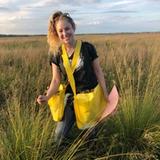Turf pests—insects and organisms that invade lawns—can cause significant damage before you even notice them. Let's learn how to spot, prevent, and manage these unwanted visitors.
Signs of turf pest damage
Watch for these telltale signs:
- Chew marks on plant tissue
- Uprooted turf
- Mounds or tunnels in your lawn
- Yellowing patches
- Thinning grass
- Bare spots
Sunday Tip:
Damage caused by many turf pests can be confused with drought stress. Want to learn how to tell the difference quickly? If turf pulls up easily, it’s likely a turf pest issue. If turf does not pull up easily, it’s likely drought stress.
Early detection of turf pests matters
Catching pest problems early can mean the difference between a simple fix and a complete lawn renovation.
Early detection typically means you'll only need minor repairs and spot treatments, allowing your lawn to bounce back quickly.
But when pest problems go unchecked, the consequences multiply.
You'll likely face extensive lawn damage requiring multiple treatments, which means higher costs and greater environmental impact from increased pesticide use. You might even need to restart your lawn from scratch in severe cases.
Smart turf pest management
The key is integrated pest management (IPM)—a systematic approach that combines prevention and control:
- Regular monitoring. Check your lawn frequently, especially during peak pest seasons.
- Proper identification. Learn to recognize common pests and their damage patterns.
- Timely response. Take action as soon as you spot signs of trouble.
- Evaluation. Track what works and adjust your approach as needed
Sunday Tip:
Before treating any pest problem, confirm what you're dealing with. Different pests need different solutions!
Guide to common lawn pests
Billbugs
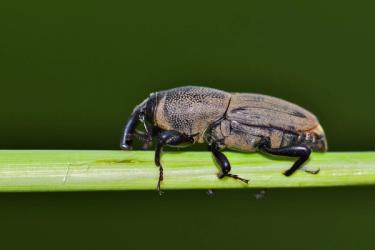
Type of pest: Larvae of weevils that feed on turfgrass stems, crowns, and roots
Important species to know:
- Bluegrass billbug (Sphenophorus parvulus)
- Hunting billbug (Sphenophorus venatus)
Susceptible turfgrass: All turfgrass species
How to identify: ¼ inch to ½ inch long, C-shaped larvae that are cream to white in color with brown heads. ID tip: a key identifier of billbug larvae (versus other grubs) is the absence of legs!
When they're active: Typically active from spring through summer, with peak activity and damage occurring in June and July
Where you’ll find them in your yard: Within grass stems, throughout the root zone, and most commonly in your grass’s thatch
Damage: Look for sporadic brown or dead turf patches that can be pulled up easily from the lawn. Another tell-tale sign of billbugs is the light brown frass (insect poop) they leave behind in the damaged, hollowed-out turf.
How to check for billbugs: If you think you might have billbugs, first check if the soil pulls up easily and then cut 1 square foot of turf to expose the soil to look for larvae.
How to manage: If possible, try to control adult weevil populations in early spring to prevent a billbug larval infestation in the summer. If you cut open your turf and see 10+ legless, C-shaped larvae, you may need to utilize insecticides or seek professional assistance (depending on the time of year).
Chinch bugs
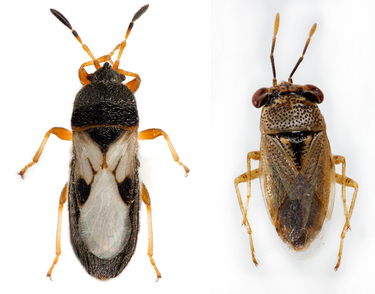
Credit: D. S. Reiland, NCSU Turffiles
Type of pest: A fast-moving bug that loves thatch and consumes grass
Important species to know:
- Common chinch bug (Blissus leucopterus leucopterus)
- Hairy chinch bug (B. leucopterus hirtus)
- Southern chinch bug (B. insularis)
- Western chinch bug (B. occiduus)
Susceptible turfgrass: Chinch bugs are prevalent across northern and southern climates and prefer warm- and cool-season grasses that produce thatch.
How to identify: Roughly ¼ inch, oval-shaped black body with white wings that create a triangular spot on its back
When they're active: These bugs are active spring through fall but most common during the warmer, dry season, so chinch bug damage is commonly confused with drought conditions!
Where you’ll find them in your yard: Just below the crown and within the thatch where chinch bugs live and feed on the base of the grass
Damage: Can range from wilted grass and discoloration to large yellow or brown patches and pieces of lawn becoming unrooted and easily pulled up from the ground
Sunday Tip:
The first sign of chinch bug damage is visual. When chinch bugs feed on grass, the saliva they emit during feeding prevents the movement of nutrients and water in the plants. This chemical reaction causes grass to wilt or become discolored regardless of watering practices.
Checking for chinch bugs: These pests move quickly and are difficult to ID. Perform a DIY Flood Method Survey to ensure you identify chinch bugs correctly.
How to manage:
- If it’s a minor infestation (<10 per square yard), you must dethatch to force chinch bugs out and reintroduce better lawn care practices.
- If it's moderate (10–20 per square yard), follow previous solutions and add endophytic grass, or grass infected with good fungi, to help repel chinch bugs.
- If the issue is severe (20+ per square yard), follow previous solutions to build better resiliency to insect injury, and then determine if chemical control is necessary.
Cutworms
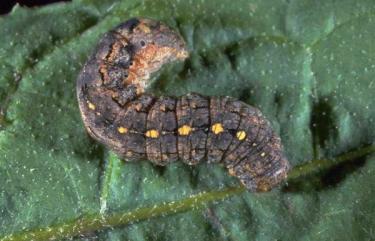
Credit: Frank Peairs, Colorado State University
Type of pest: Immature moth, or caterpillar that feeds on turfgrass
Important species to know
- Variegated cutworm (Peridroma saucia)
- Black cutworm (Agrotis ipsilon)
Susceptible turfgrass: All turfgrasses
How to identify: Thick, non-hairy caterpillars marked with stripes, and can range in color from gray to reddish-black with shades of pink, yellow, or green. They tend to curl up when disturbed.
When they're active: Typically active in spring and fall
Where you’ll find them in your yard: Cutworms will emerge from the soil at night to feed on grass and will utilize tunnels or aeration holes to move around in the first few inches of soil.
Damage: Cutworms are very destructive to lawns—especially already stressed lawns—and will chew off grass blades just above the soil at the crown. This type of feeding causes thinning and brown spots across the lawn.
How to check for cutworms: Use the soap flush technique (below).
How to manage:
- If you find some cutworms after implementing the soap flush technique, revisit Sunday lawn care best practices, audit your watering practices, and introduce better grass varieties.
- If there are 10+ cutworms per 1 square yard, you may need to consider insecticides or seek professional assistance.
How to do the soap flush technique
You can utilize this technique for cutworms, weevils, webworms, chinch bugs, mole crickets, armyworms, black turfgrass ataenius, and more! The soap mixture irritates the worms and brings pests to the surface to confirm their presence, identification, and level of infestation.
- Mix 1 gallon of water and 1–2 tablespoons of lemon dish detergent. Mix enough to create some suds.
- Pour the soapy mixture over 1 square yard of turf, and try to include both damaged and undamaged areas into the soap flush area*.
- Watch closely for 5–10 minutes, then identify and count the number of turf pests that appear.
- If there are more than 5–10 (depending on the species) of the same pests per square yard, you may need to seek out insecticide or professional pest control solutions.
*The soap flush method will not damage turfgrass, but should not be used frequently to avoid stressing the turf.
Fall armyworms
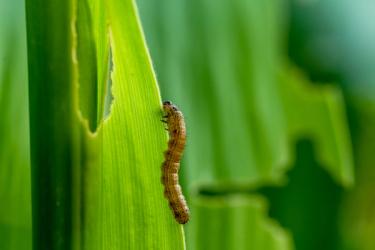
Type of pest: Moth caterpillars that eat grass tissue
Susceptible turfgrass: All types of turfgrass, but most outbreaks occur in warm-season grass
How to identify: ¼–2 inches long, green to mottled brown in color with wide black stripes down each side of their back, four black dots on each abdomen segment, and a white upside down "Y" shape on the head capsule
When they're active: Fall armyworms are periodic pests—meaning an outbreak won’t happen yearly. In an outbreak year, they’re typically active from June to November until a hard frost hits.
Where you’ll find them: Above ground in grass tissue, in large populations that seemingly appear overnight
Damage: Once established, fall armyworms feed en masse across a lawn like an army moving across a battlefield. As the larvae feed on grass tissue, you’ll see bare spots that, if left unchecked, result in a dead, completely consumed lawn.
How to check for fall armyworms: Use the soap flush technique
How to manage: If fall armyworms are present in your lawn, there is likely a large population that will be difficult to control. You can allow natural predators like birds, rodents, or other insects to feast on the population. Otherwise, consider insecticides or professional assistance. To restore your lawn after an armyworm infestation:
- Replant grass across it
- Irrigate properly
- Then fertilize once it grows back.
Sunday Tip:
Armyworms tend to be associated with influxes of severe weather when storms carry adult moths in. When this happens, moths seek shelter near flat surfaces (like lawns) and lay hundreds of eggs on surrounding plants or structures. Soon after, the eggs hatch, and larvae fall into the lawn to feast.
Grubs
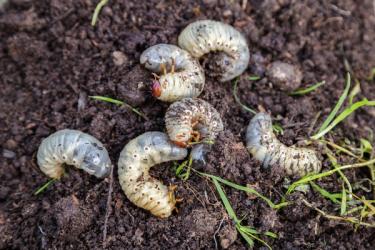
Type of pest: Grubs are one of the most damaging turf pests. This group is made up of various larvae of different insects, primarily beetles and chafers.
Important species to know
- Masked chafer (Cyclocephala spp.), European chafer (Rhizotrogus majalis)
- Japanese beetle (Popillia japonica)
- Black turfgrass ataenius (Ataenius spp.), is not common in residential lawns
Susceptible turfgrass: All turfgrasses
How to identify: C-shaped, white body, red-orange to yellow-brown head, raster at tip and legs
When they're active: Typically active spring to fall, but damage can appear as early as May into mid-late summer
Where you’ll find them: Several species are widespread, while others are only found in certain geographic regions, but grubs are primarily found in the first 1–2 inches of soil below the turf. Grubs tend to infest the same areas year after year, so if you saw them last year, chances are you’ll see them in the same spot this year.
Damage: Damage can range from stressed turf to animal or bird foraging.
- Stressed turf. Larvae chew and feed on grass roots and organic matter. As they grow, they consume more, which can cause turf to brown or die. Turf can pull up or roll up easily, similar to loose carpet or sod.
- Animal or bird foraging. The presence of grubs can also attract predators (like raccoons).
Jumping worms
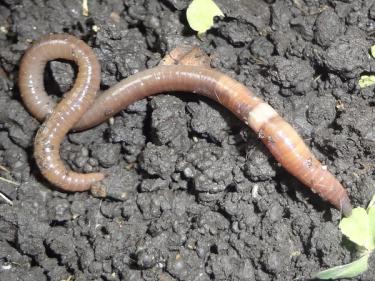
Photo by Alfredo Eloisa, licensed under CC BY-NC-SA 2.0.
Type of pest: A fast-damaging earthworm that disrupts soil and grass growth
Important species to know:
- Jumping worms (Amynthas spp.)
Susceptible turfgrass: All turfgrass species can be hosts.
How to identify: This earthworm is between 1.5 and 8 inches long, with a shiny pink to brownish gray body and a cream to tan-colored clitellum, or ring, that goes all the way around the body but is flush with the body instead of protruding (like other worms).
When they're active: Typically, early spring to late fall, but they can remain active as long as soil temperatures are warm
Where you’ll find them in your yard: In the top soil layer, as well as potentially in thatch, leaf litter, and compost piles
How to check for jumping worms: Cut back some of your lawn to the soil and look for worms. If you see worms, try to pick them up with a gloved hand and see if any thrash wildly or “jump” when handled. You can also check for their frass or poop, which looks like small coffee grounds.
Damage: Jumping worms eat through the soil, stripping it of nutrients and organic matter while destroying soil structure. Without these key attributes, plants and grass will begin to show signs of damage (like yellowing or thinning) and can die off.
How to manage: Jumping worms are now listed as an invasive species, which means they cannot be controlled easily based on their adaptability to many habitats and ability to produce rapidly. So, the best way to manage jumping worms is to prevent them. Monitor your yard, check products before you buy or transport them to your yard, clean your garden tools regularly, purchase quality fishing bait, and dispose of unused bait properly. Also, if you find a jumping worm, hand trap it and dispose of it.
Mole crickets
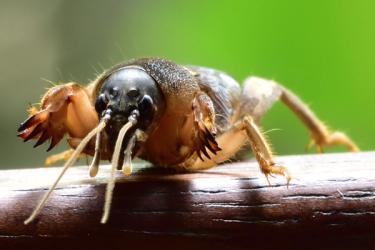
Type of pest: Subsurface tunneling cricket that feeds on grass
Important species to know:
- Tawny mole cricket (Scapteriscus vicinus)
- Southern mole cricket (S. borellii)
Susceptible turfgrass: All types of turfgrass
How to identify: 1–2 inch-long insect that ranges from tan to dark brown in color and has a very distinctive cricket-shaped body with mole-like forelegs built for tunneling through soil
When they're active: Typically active early spring to fall, but peak damage tends to occur in late summer to early fall
Where you’ll find them in your yard: At the soil surface and just underneath your grass within the tunnels they build through in the top layer of the soil.
Damage: Mole crickets eat grass roots and shoots and create systems of tunnels throughout the lawn.
How to check for mole crickets: Use the soap flush technique.
How to manage:
- Most residential lawns can tolerate small populations of mole crickets. They can recover from minor lawn damage with improved lawn care practices, proper mowing, irrigation auditing, and planting better grass varieties.
- If there is significant lawn damage or extensive tunneling across the lawn, you may need to consider insecticides or seek professional assistance.
Sunday Tip:
Mole crickets will return year after year to the same location in the lawn. If you find mole crickets in your lawn, recheck the same area annually and make sure to heavily plant grass in these zones to repair the damage.
Mound-building ants
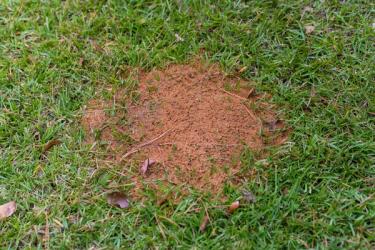
Type of pest: Ants that build large, unsightly mounds in lawns and can sting or bite
Important species to know:
- Harvester ants (Pogonomyrmex spp.)
- Fire ants (Solenopsis spp.)
Susceptible turfgrass: Warm-season lawns in southern regions for fire ants. Every grass type except lawns in the northeast can host harvester ants.
How to identify:
- Harvester ants: Small ants (¼–½ inch long), orange to red or brownish-black in color. The second body section has a pair of spines on the top, and many have long "beards" on their heads.
- Fire ants: These small (about ⅛–¼ inches long) fire red ants have a waist consisting of two distinct nodes or bumps between the middle and rear body segments.
When they're active: Harvester ants are active at temperatures above 60 degrees Fahrenheit, which can mean year-round activity. Fire ants are in peak activity between 72 and 96 degrees Fahrenheit but can remain active between 50 and 123 degrees F.
Where you’ll find them in your yard: In and around large, raised mounds within a lawn or yard
How to check for ants: Look for earth mounds.
Damage: Large ant mounds across a landscape are stripped of all vegetation, range in diameter from a few inches to a few feet, and often have loose soil, sand, or pebbles expelled from the mound opening.
How to manage: Unfortunately, these pests are hard to control without effective pest control products and if untreated can potentially be harmful to you, your family, or your pets.
Sod webworms
Credit: David R. Smitley, Michigan State University
Type of pest: Immature moth or caterpillar that feeds on turfgrass
Susceptible turfgrass: Webworms prefer warm-season lawns but are often found in dry or heat-stressed cool-season lawns.
How to identify: Dark brown head, caterpillar-like body, with coloration that ranges from brownish to grayish with black spots
When they're active: Typically late spring to late summer, with activity most evident during dry periods
Where you’ll find them: During the day, sod webworms can be found within soil tunnels, tunnels constructed with silk in thatch, or at the soil line. In the evening, they emerge onto the lawn to feed on grass.
Damage: Sod webworms tend to eat turfgrass at the crown and can chew grass down to the soil. The damage level will depend on your lawn's condition and climate like heat or drought.
How to check for cutworms: Use the soap flush technique.
How to manage:
- If you find small populations of sod webworms, revisit Sunday lawn care best practices, audit your watering practices, and introduce better grass varieties.
- If there are more than 10 webworms per 1 square yard, you may need to consider insecticides or seek professional assistance.
How to prevent turf pests in your lawn
Good cultural practices will help prevent issues in your lawn naturally and help grow a healthy lawn that's more resilient to insect injury while reducing the need for pesticides. Here's what good cultural practices look like:
- Proper irrigation and seasonal irrigation audits
- Well-timed, low-rate applications of fertilizer
- Mowing at the right height for your grass type
- Planting better grass types, especially endophytic turfgrasses
Other ways to prevent pests
- Plan for potential pest problems before planting grass.
- Keep records of past issues at your site(s) to continue to monitor annually.
- If your grass is stressed from climate or other stressful conditions, avoid stressing it out further—it is more susceptible to pests.
Remember, a healthy lawn is the best defense against most insect pests.
Cited sources
2022 Fall Pest Update | Turf Files. North Carolina State University.
Armyworms and cutworms in turfgrass. Utah State University Extension
Chinch Bugs. Penn State University Extension.
Controlling Fall Armyworms on Lawns and Turf. North Carolina State Extension.
Cutworms in Turf. North Carolina State University Extension.
Developing an Integrated Turfgrass Pest Management Program. Penn State University Extension.
Fall Armyworms in Turf. North Carolina State University.
Healthy Lawns—Manage Pests. UC-Davis Extension IPM.
How do I treat for grubs in my lawn? University of New Hampshire Extension.
Invasive Species: Jumping Worms. Cornell Cooperative Extension.
Japanese Beetles. UMN Extension.
Lawn care calendar. UMN Extension
Mole Cricket Management in Turfgrass. Clemson University Extension.
Monitoring for Turf Insects. North Carolina State University Extension.
Sod Webworms. University of New Hampshire Extension.
Turfgrass Insects. Missouri University Extension.
Turfgrass | Landscape Pest Management. University of Georgia Extension.
Turfgrass - Sod Webworms. University of Nebraska-Lincoln Extension.
Turf Pests. Utah State University Extension.
Weed, Insect and Disease Control in Turfgrass. Texas A&M AgriLife Extension.
White Grubs. University of New Hampshire Extension.


